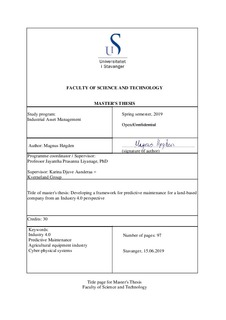| dc.contributor.advisor | Djuve Aanderaa, Karina | |
| dc.contributor.advisor | Liyanage, Jayantha Prasanna | |
| dc.contributor.author | Høgden, Magnus | |
| dc.date.accessioned | 2019-10-09T07:00:58Z | |
| dc.date.available | 2019-10-09T07:00:58Z | |
| dc.date.issued | 2019-06 | |
| dc.identifier.uri | http://hdl.handle.net/11250/2621048 | |
| dc.description | Master's thesis in Offshore Technology : Industrial Asset Management | nb_NO |
| dc.description.abstract | The manufacturing industry today is filled with buzzwords like Industry 4.0, digitalization and automation. Emerging technologies enable operators and companies to better control asset lifetime, operations, failures and maintenance. The majority of the benefits obtained through the emerging technologies are achieved by analysing collected data. The transformation of data from the physical plane into the cyber-physical one is challenging, often due to lack of standards for organizations and work processes. With these challenges at its core, Industry 4.0 and digitalization projects are difficult to navigate around to make them successful.
This thesis focuses on answering the research question of: “How can a framework for predictive maintenance be developed and implemented in a land-based company in a cost-efficient way” in order to address the challenges in the industry. Hence, the framework developed will act as a guideline for a process of developing and implementation of predictive maintenance compliant with the Industry 4.0 concept.
The selected industrial case study is Kverneland Group and the focus of this thesis is related to the A300 mechanical forge press at their factory at Klepp as this is evaluated as their top 10 most critical equipment based on value produced. In order to evaluate the framework developed, it is demonstrated in use through our case study, on a machine and organizational level.
The framework presented in this thesis proposes a six-layered approach toward development and six-steps for implementation of predictive maintenance. The process proposed for how these can be combined is presented through a four-step model based on the framework and strategy developed.
The system analysis of the A300 was used as a critical element in evaluating the framework for the development of a predictive maintenance system. This methodology was used to identify the most critical assets and subsystems, as it would capture the critical elements with the most potential and benefits by being enabled by Industry 4.0 technologies and making the analogue to digital transformation. The analysis highlights the most critical failure scenario within the A300, it also suggests parameters that can be used for monitoring purposes. This monitoring is performed by vibration sensors that detect the shift in the natural frequency as a symptom of failure.
The framework developed illustrates how the six-layered architecture can be used to form a standardised approach to predictive maintenance development. It elaborates on the different layers and their respective requirements, which can be used when establishing a predictive maintenance system. This framework was further used in developing a six-step model for successful implementation of predictive maintenance along with a systematic process approach that complies with the Industry 4.0 concept.
The cost benefit analysis performed concludes with that the cost of establishing and maintaining a predictive maintenance system is a viable option. For a period of 10 years, monitoring the specific machine fault discovered and implementing predictive maintenance, could potentially mitigate the risk cost associated with it. | nb_NO |
| dc.language.iso | eng | nb_NO |
| dc.publisher | University of Stavanger, Norway | nb_NO |
| dc.relation.ispartofseries | Masteroppgave/UIS-TN-IMBM/2019; | |
| dc.rights | Navngivelse-Ikkekommersiell 4.0 Internasjonal | * |
| dc.rights.uri | http://creativecommons.org/licenses/by-nc/4.0/deed.no | * |
| dc.subject | industrial asset management | nb_NO |
| dc.subject | predictive maintencance | nb_NO |
| dc.subject | industry 4.0 | nb_NO |
| dc.subject | agricultural equipment industry | nb_NO |
| dc.subject | cyber-physical systems | nb_NO |
| dc.subject | offshore teknologi | nb_NO |
| dc.subject | driftsledelse | nb_NO |
| dc.title | Developing a framework for predictive maintenance for a land-based company from an Industry 4.0 perspective | nb_NO |
| dc.type | Master thesis | nb_NO |
| dc.subject.nsi | VDP::Technology: 500::Marine technology: 580::Offshore technology: 581 | nb_NO |

